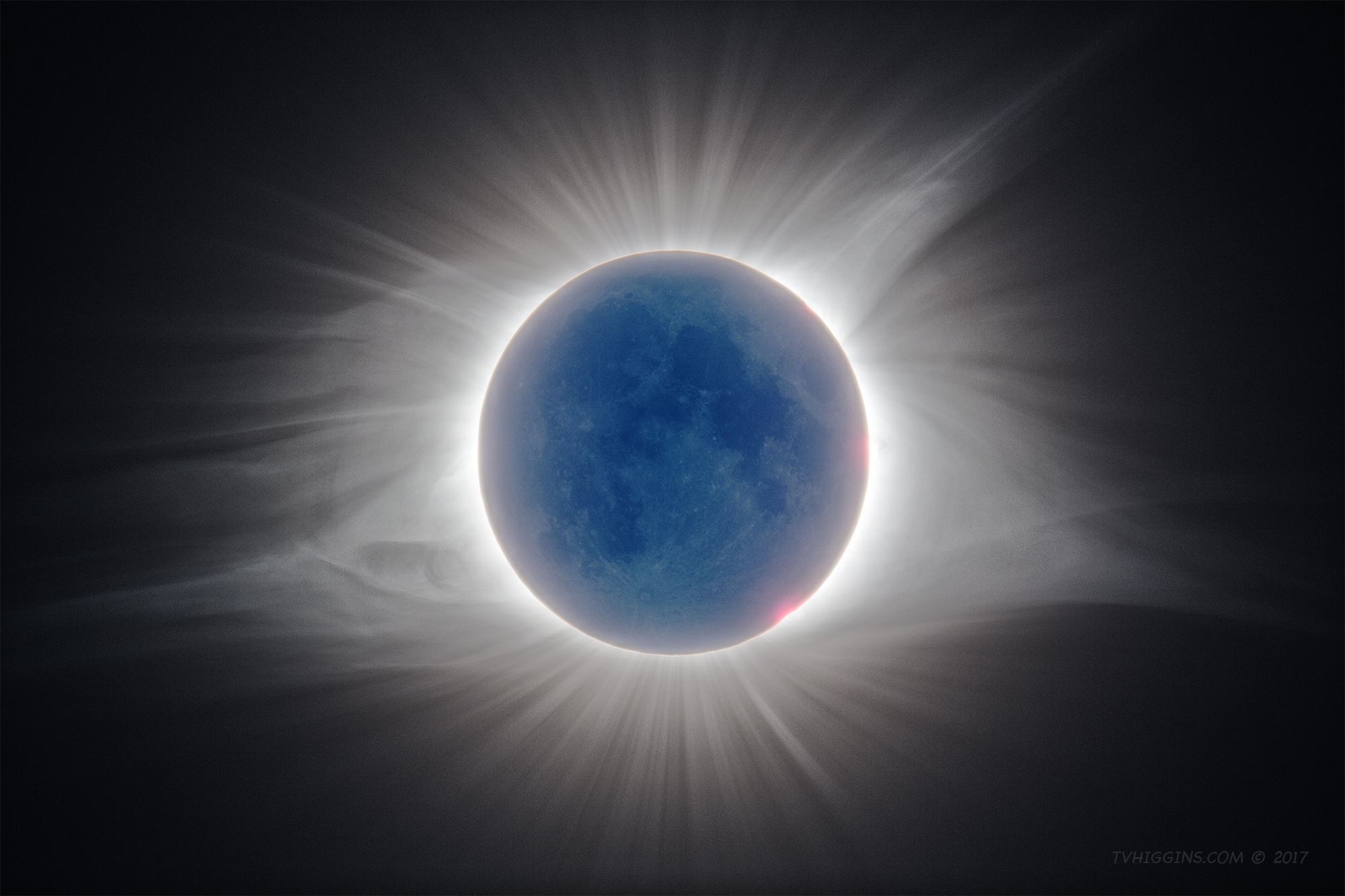
A high-dynamic-range image showcases the solar corona and the Moon during The Great American Eclipse of 2017.
- Telescope: Stellarvue SVA130T-IS
- Mount: Losmandy G-11 with Gemini 2 controller
- Autoguiding: No
- Optical Configuration: 0.72x field flattener & reducer (f/5); no solar filter during totality
- Camera: Canon 60Da
- Light Frame(s): 6 frames from 1/500 sec to 1 sec
- Calibration: None (no darks, no flats, no biases)
- Exposure Time(s): 1/500, 1/250, 1/125, 1/60, 1/30 sec, and 1 sec
- ISO: 100
- Processing: Photoshop CC using HDR Pro
- Imaging Location: Prairie City, Ore.
This high-dynamic-range image reveals many lunar features along with the detailed structure of the solar corona during The Great American Eclipse of 2017. Super-heated plasma escaping from the sun creates the solar corona and becomes the solar wind that blows through our solar system at a million miles per hour. The charged particles that make up the coronal plasma follow the magnetic field lines of the sun and form streamers in the corona, like iron filings around a magnet. In this image, north is up, south is down, east is left, and west is right.
Sunlight reflecting from our Earth during the eclipse illuminates the Moon and bounces back to Earth as “earthshine.” Because of this earthshine, lunar features such as the “seas” and several large craters (Tycho, Copernicus, etc.) can be imaged during totality. The blue color of the Moon comes from our blue sky.
Hello Thomas,
I found your eclipse picture on a google search for earthshine images. This one stood out as an outstanding example. I understand the gist of HDR photography, but am curious how you managed to shoot six frames at different exposures in, presumably. a short time.
Is there some camera automation involved?
Thanks, Shaun. Yes, automation was involved. I used a program called BackyardEOS to automate the bracketed exposures during the eclipse. That way I could enjoy all two minutes and six seconds of totality without hovering over my equipment. Altogether, I took 16 exposures during totality, ranging from 1/2000 to 2 sec. in one-stop increments. There was some duplication in exposure times. All sub-frames were shot at ISO 100. I cherry-picked those exposures that yielded the best HDR image.
One processing challenge is that the Moon moves during the 16 exposures, leading to multiple images of the lunar disk in the HDR stack. (I stacked the sub-frames pixel-over-pixel to keep the relatively stationary solar corona sharp.) To address the multiple lunar images, I used a clipping mask to isolate the lunar disk from the best earthshine sub-frame (a 1-sec. exposure) and enlarged it just enough to cover the other lunar images in the stack. This is why you don’t see multiple lunar disks in the final HDR image. The technique is widely used among eclipse photographers looking to get good coronal and lunar detail.
I’m grateful that you appreciate the work behind this image. I was very happy with the final result. Hope I gave you some more insight into the process.
Thomas,
Thanks for the reply and the insight into how you did it. I’ve shared this with some friends and we all agree that this is the finest example we’ve seen, and we’ve looked at quite a few of them.
We’ve also been looking at images of the ISS transit across the sun and those are interesting too.
Thanks again and all the best with your work.
Tom,
Thank-you for sharing! I was there in Prairie City with you, but of course I wasn’t able to see (without equipment) these images. I feel a connection to these images that I probably wouldn’t have if you hadn’t been so open to questions from a total novice like myself. Thanks again.
Thanks, Terry. I wouldn’t know how to keep this stuff to myself. Just looking up on a clear night is enough to get me going. But, a total eclipse of the sun? That’s something you never forget. I feel lucky to be able to share it with others like you who witnessed it as well as those who just can’t stop looking up. Clear skies!